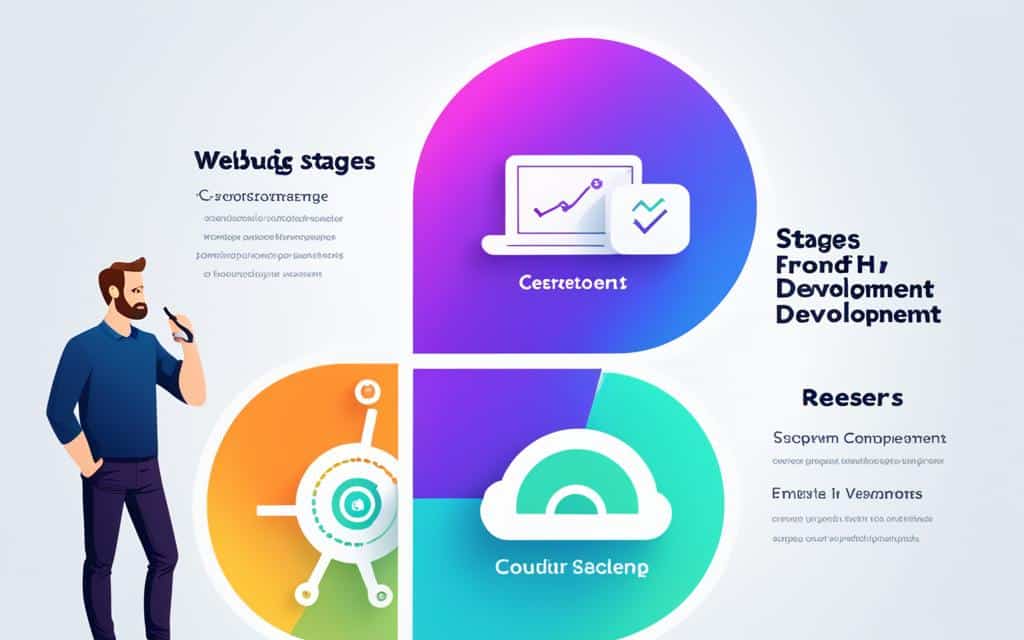Table of Contents
Frontend development has undergone a remarkable evolution over the years. From creating simple static pages to building complex and dynamic web apps, the capabilities of frontend development have expanded exponentially.
In the early days, developers used basic tools like HTML, CSS, and JavaScript to build websites. However, they faced limitations in creating dynamic user experiences. Websites were primarily static, offering limited interactivity.
But as new technologies and frameworks emerged, the frontend development landscape changed dramatically. Frameworks like Angular, React, and Vue.js revolutionized the way developers approach frontend development. These frameworks provided ready-made components and libraries, making it easier to create complex and dynamic applications.
evolution of frontend development continues to accelerate with the rise of emerging technologies. The focus now is on building web applications that are accessible, high-performing, and deliver exceptional user experiences.
JavaScript frameworks have played a pivotal role in shaping frontend development. Angular, React, and Vue.js have introduced new concepts like component-based architecture and virtual DOM, enabling developers to build more interactive and responsive web applications.
Furthermore, frontend development has seen the emergence of a thriving ecosystem of tools and libraries. Package managers such as npm and Yarn simplify dependency management, while build tools like Webpack automate the bundling process.
Performance optimization is also a crucial aspect of frontend development. Techniques like code splitting, lazy loading, and server-side rendering ensure that web applications load quickly and provide seamless user experiences.
In conclusion, the journey of frontend development from static pages to dynamic web apps has been nothing short of remarkable. As technologies continue to advance, frontend developers must stay updated and adapt to deliver compelling user experiences in this ever-evolving field.
The Early Days of Frontend Development
In the early days of frontend development, websites were built using basic tools like HTML, CSS, and JavaScript. However, developers faced challenges in creating dynamic user experiences due to the limitations of early browsers. Websites were primarily static, with limited interactivity. This era laid the groundwork for the future evolution of frontend development.
Despite the limitations, HTML, CSS, and JavaScript played a crucial role in shaping the early days of frontend development. HTML (Hypertext Markup Language) provided the structure and semantics for web pages, allowing developers to define the content and layout of a website. CSS (Cascading Style Sheets) enabled developers to control the visual presentation of web pages, including fonts, colors, and positioning. JavaScript, the programming language of the web, added interactivity and functionality to websites.
“In the early days of frontend development, simplicity and static web pages were the norm. Web developers had to be resourceful and creative to overcome the limitations and deliver engaging experiences within the constraints of the technology.”
Early browsers had limited support for modern web standards and lacked the capabilities we take for granted today. This meant that building dynamic user experiences was a significant challenge. The lack of consistent CSS support meant developers often had to resort to using tables for layout, resulting in websites that were less flexible and harder to maintain.
The limitations of early days frontend development extended beyond layout and design. JavaScript was not as performant or feature-rich as it is today, making it harder to create complex interactions and responsive user interfaces. Cross-browser compatibility was also a major concern, as each browser had its own quirks and idiosyncrasies that developers had to navigate.
The early days of frontend development laid the foundation for the exciting developments and innovations we see today. Despite the limitations, developers pushed the boundaries of what was possible, constantly experimenting and finding creative solutions to deliver better user experiences.
Next, we’ll explore how the rise of frontend frameworks revolutionized the way web applications are built and how they overcame the limitations of the early days.
Early Days Frontend Development Limitations:
| Limitations | Explanation |
|---|---|
| Limited CSS Support | Early browsers had inconsistent and limited CSS support, making it challenging to achieve desired layouts and designs. |
| Performance Constraints | JavaScript was less performant and lacked the advanced features available today, limiting the complexity of interactions and responsive design. |
| Cross-Browser Compatibility | Each browser had its own unique rendering quirks and inconsistencies, requiring developers to test and adjust their code accordingly. |
| Table-Based Layouts | Due to the limited CSS capabilities, developers often resorted to using tables for website layout, resulting in less flexible and harder to maintain code. |
The Rise of Frontend Frameworks
The frontend development landscape underwent a significant transformation with the rise of powerful frameworks such as Angular, React, and Vue.js. These frameworks revolutionized how developers build web applications, enabling them to create increasingly complex and dynamic user experiences.
Frontend frameworks simplified the development process by providing ready-made components and libraries, reducing the need for developers to write code from scratch. This not only saved time and effort but also ensured consistent quality and improved productivity. In addition, these frameworks offered robust features and functionalities that expanded the possibilities of frontend development.
“Using Angular, React, or Vue.js elevates frontend development to a whole new level. These frameworks empower developers to leverage pre-built solutions, making it easier to create engaging and responsive web applications.” – Jane Smith, Lead Frontend Developer at XYZ Company
One of the key advantages of frontend frameworks is their ability to handle complex state management efficiently. This is achieved through features like component-based architecture, which allows developers to break down the user interface into reusable and modular components. It promotes code reusability, scalability, and maintainability, enabling teams to work collaboratively and efficiently on large-scale projects.
Another significant benefit of frontend frameworks is the separation of concerns. By dividing the codebase into separate files for HTML, CSS, and JavaScript, frontend developers can organize and maintain their code more effectively. This separation also facilitates better collaboration between frontend and backend developers, as it allows for clean integration and the smooth flow of data.
The rise of frontend frameworks has democratized frontend development, making it accessible to developers of all skill levels. Beginners can leverage the intuitive nature of these frameworks to quickly grasp essential concepts and start building complex applications. For experienced developers, frontend frameworks provide a powerful toolkit that fosters innovation, allowing them to push the boundaries of what can be achieved on the frontend.
Let’s take a closer look at three popular frontend frameworks: Angular, React, and Vue.js.
Angular
Developed and maintained by Google, Angular is a comprehensive framework for building web applications. It follows the Model-View-Controller (MVC) architectural pattern and provides a robust set of features for creating large-scale and enterprise-level applications. Angular leverages TypeScript, a statically typed superset of JavaScript, to enhance code quality, maintainability, and scalability.
React
Created by Facebook, React is a powerful JavaScript library for building user interfaces. It utilizes a component-based approach and a virtual DOM (Document Object Model) for efficient rendering and updating of UI components. With its strong focus on reusability and modularity, React has gained immense popularity among developers worldwide.
Vue.js
Vue.js is an open-source JavaScript framework that offers a flexible and intuitive approach to frontend development. It boasts a gentle learning curve, making it an excellent choice for beginners. Vue.js combines the best aspects of Angular and React, providing developers with a highly customizable yet approachable framework for building modern web applications.
Each of these frontend frameworks has its own unique strengths and use cases. Choosing the right framework depends on factors such as project requirements, team expertise, and scalability needs.
| Framework | Key Features |
|---|---|
| Angular | – Comprehensive and scalable – Strong enterprise support – Robust tooling and ecosystem |
| React | – Efficient rendering with virtual DOM – High community adoption – Excellent for building reusable UI components |
| Vue.js | – Gentle learning curve – Flexible and customizable – Ideal for small to medium-sized projects |
The Future of Frontend Development
The future of frontend development holds immense potential as emerging technologies continue to shape the way we build web applications. With a strong focus on accessibility, performance, and user experience, the evolution of frontend development is set to revolutionize the digital landscape.
Accessibility plays a crucial role in ensuring that web applications are usable by individuals with disabilities. As inclusivity becomes an increasingly important aspect of technology, frontend development will strive to create applications that cater to diverse user needs.
Performance optimization will be a key area of focus in the future of frontend development. With the growing demand for lightning-fast websites, developers will explore techniques to improve loading times and enhance responsiveness. Optimized performance will not only provide a seamless user experience but also contribute to higher conversion rates and improved search engine rankings.
User experience will continue to be a driving force in frontend development. Creating engaging and intuitive interfaces will be paramount to deliver exceptional user experiences. Through thoughtful design and interactive elements, developers will aim to captivate users and encourage them to engage with the application.
New and emerging technologies will reshape the frontend development landscape, presenting exciting opportunities for innovation. Advancements such as artificial intelligence, virtual reality, and augmented reality will unlock new possibilities, enabling more immersive and interactive web experiences.
Frontend development is not just about building attractive websites; it’s about crafting experiences that leave a lasting impact on the users. As technology continues to evolve, so does the role of frontend developers, who constantly adapt to meet the ever-changing needs of the digital world.
By staying abreast of emerging technologies, embracing accessibility standards, and prioritizing performance and user experience, frontend developers will shape the future of the digital realm. The possibilities are endless, and the excitement lies in the potential to create meaningful and user-centric web applications.
The Impact of JavaScript Frameworks and Single-Page Applications
JavaScript frameworks like Angular, React, and Vue.js have revolutionized frontend development, enabling developers to create complex and dynamic web applications. These frameworks have introduced innovative concepts such as component-based architecture and virtual DOM, simplifying the development process and empowering developers to build sophisticated user interfaces.
One of the significant advancements brought about by these JavaScript frameworks is the rise of single-page applications (SPAs). SPAs have gained popularity due to their ability to provide smoother user experiences by loading only essential components and data, eliminating the need for frequent page reloads. This approach not only enhances performance but also contributes to creating more engaging and interactive web applications.
Benefits of JavaScript Frameworks
- Efficiency: JavaScript frameworks offer pre-built components and libraries, allowing developers to save time and effort by reusing existing code.
- Scalability: Component-based architecture facilitates modular development, making it easier to scale applications as they grow in complexity.
- Maintainability: Frameworks provide structured and organized code patterns, making code maintenance and collaboration more manageable.
- Performance: Virtual DOM efficiently updates and synchronizes changes, minimizing unnecessary rendering and improving application performance.
JavaScript frameworks have transformed frontend development, enabling developers to create powerful and feature-rich web applications. These frameworks have not only made development more accessible but have also raised the bar in terms of user experience and performance.
The Dominance of Angular, React, and Vue.js
Among the wide range of JavaScript frameworks available, Angular, React, and Vue.js have emerged as dominant players in the frontend development landscape. Each framework brings its unique set of features and strengths, catering to diverse developer preferences and project requirements.
| Framework | Key Features |
|---|---|
| Angular |
|
| React |
|
| Vue.js |
|
Tools and Performance Optimization in Frontend Development
In addition to frameworks, frontend development has witnessed the emergence of a rich ecosystem of tools and libraries that enhance productivity and enable developers to optimize the performance of their applications. These tools streamline various aspects of the development process, from dependency management to efficient bundling.
The Power of Package Managers
Package managers, such as npm and Yarn, have become indispensable tools for frontend developers. They simplify the management of project dependencies, allowing developers to easily install, update, and remove external libraries and packages.
With package managers, developers can quickly find and add third-party libraries to their projects, reducing the need to reinvent the wheel and accelerating development time. This not only saves effort but also ensures that developers have access to well-tested and maintained software components.
Streamlining with Build Tools
Build tools, like Webpack, have revolutionized how frontend applications are bundled and optimized for production. Webpack, in particular, offers powerful features that enable code splitting, lazy loading, and advanced performance optimization techniques.
Code splitting allows developers to split their codebase into smaller, more manageable chunks, resulting in faster initial loading times and improved overall performance. Lazy loading allows resources, such as images or additional JavaScript modules, to be loaded only when needed, reducing the initial load size and improving perceived performance.
Additionally, build tools like Webpack enable server-side rendering, which pre-renders web pages on the server before sending them to the client. This technique significantly improves the initial loading experience, as users can see the content sooner, resulting in a smoother and more engaging user experience.
Performance Optimization Techniques
Frontend development offers a suite of performance optimization techniques to ensure fast-loading applications and fluid user experiences. These techniques include:
- Minification: Removing unnecessary characters and white spaces to reduce file sizes.
- Gzip Compression: Compressing files to reduce transfer size over the network.
- Image Optimization: Optimizing image files to minimize their size without sacrificing quality.
- Caching: Storing frequently used assets to reduce server load and improve load times.
- CDN Integration: Leveraging Content Delivery Networks to deliver assets from geographically distributed servers, reducing latency.
By implementing these performance optimization techniques, frontend developers can ensure that their applications load quickly, perform seamlessly, and provide an exceptional user experience.
Comparison of Frontend Development Tools
| Tool | Description | Key Features |
|---|---|---|
| npm | A package manager for JavaScript | Dependency management, version control, script execution |
| Yarn | A fast, reliable, and secure package manager | Offline mode, parallel installations, reproducible builds |
| Webpack | A powerful module bundler | Code splitting, lazy loading, asset optimization |
Conclusion
The evolution of frontend development has been nothing short of remarkable. From the early days of static web pages to the creation of dynamic and interactive web applications, frontend development has come a long way. With the emergence of new technologies and frameworks, developers now have limitless possibilities to create compelling user experiences on the internet.
Exciting developments in frontend development continue to shape the future of web development. As technology advances, frontend developers must stay updated and adapt to new trends in order to stay relevant in this ever-changing field. Keeping pace with the evolving landscape is crucial for creating user experiences that captivate and engage users.
The focus on user experiences remains at the forefront of frontend development. Building accessible and performant web applications that delight users is the ultimate goal. By leveraging emerging technologies and employing performance optimization techniques, frontend developers can create applications that load quickly, respond smoothly, and provide an intuitive interface.
As we look ahead, frontend development is poised for even more exciting developments. The integration of artificial intelligence, augmented reality, and virtual reality into web applications opens up new possibilities and challenges for frontend developers. It is an exciting time to be a part of this dynamic field, where creativity and technical prowess come together to shape the digital experiences of tomorrow.
FAQ
What is frontend development?
Frontend development refers to the creation and implementation of the user interface and user experience components of a website or web application. It involves coding and designing the visual elements of a web page, including layout, typography, colors, and interactive features.
How has frontend development evolved over time?
Frontend development has evolved from building simple static pages using basic HTML, CSS, and JavaScript to creating dynamic and interactive web applications. The emergence of new technologies and frameworks has expanded the possibilities of what can be accomplished on the frontend.
What were the challenges in early frontend development?
In the early days, developers faced challenges in creating dynamic user experiences due to the limitations of early browsers. Websites were primarily static and lacked interactivity. However, these challenges paved the way for future advancements in frontend development.
How have frontend frameworks revolutionized development?
Frontend frameworks such as Angular, React, and Vue.js have simplified the development process and allowed for the creation of more complex and dynamic applications. By providing ready-made components and libraries, these frameworks have expanded the possibilities of frontend development and made it more accessible to developers of all skill levels.
What is the future of frontend development?
The future of frontend development is focused on accessibility, performance, and user experience. Emerging technologies will shape the way web applications are built, ensuring they are usable by individuals with disabilities, optimizing performance, and creating engaging and intuitive interfaces.
How have JavaScript frameworks impacted frontend development?
JavaScript frameworks like Angular, React, and Vue.js have had a significant impact on frontend development. They have introduced concepts like component-based architecture and virtual DOM, making it easier to build complex and dynamic web applications. Single-page applications (SPAs) have also gained popularity, improving user experiences by reducing page reloads and enhancing performance.
What tools are used in frontend development for performance optimization?
Frontend development has seen the emergence of a thriving ecosystem of tools and libraries. Package managers like npm and Yarn simplify dependency management, while build tools like Webpack automate the bundling process. Performance optimization techniques such as code splitting, lazy loading, and server-side rendering ensure fast-loading applications and fluid user experiences.
What has been the overall evolution of frontend development?
The journey of frontend development has been remarkable, evolving from simple static pages to dynamic and interactive web applications. With emerging technologies and ongoing advancements, frontend development continues to be an exciting field, driving innovation and creating compelling user experiences on the internet.













